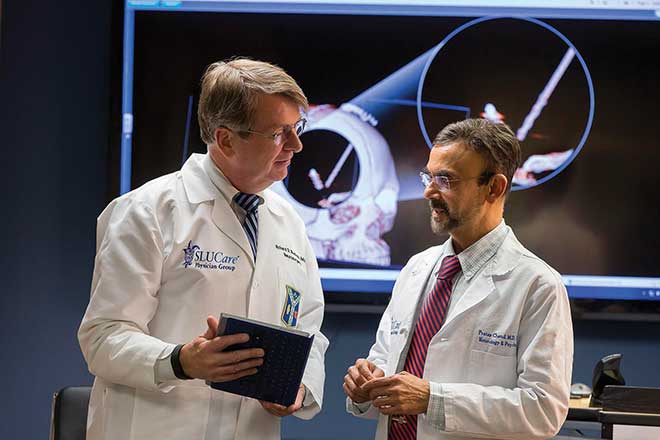Using a screwdriver. Drinking a glass of milk. For Steven Estopare, these simple acts once seemed insurmountable. “I have suffered from essential tremors since I was 13 years old,” he says. “Medications had reached their limits. The tremors affected me so dramatically no one would hire me. I had to drink with a straw without lifting the glass or I would spill it all over the place.”
Essential tremor is one of the most common movement disorders. Until recently, treatment options were limited to medications that eventually lose their effect. For years Estopare, now 53, thought that day would come for him. “It was miserable to think about,” he says.
About five years ago Estopare was referred to the SLUCare Movement Disorders Program. “There are two types of movement disorders,” says SLUCare neurologist Dr. Pratap Chand, program director and professor at Saint Louis University School of Medicine. “With one, people have involuntary movements—tremors or shaking. Sometimes there is loss of balance and falls.”
Movement disorders may result from many causes, including neurodegeneration, Chand explains. “Voluntary movements are initiated by the cerebral cortex and fine-tuned by deep structures called basal ganglia. Any disease of the basal ganglia can lead to disruption of the fine-tuning, and movements start to go out of control.”
Neurodegeneration is believed to result from aging, inherited traits or toxin exposure. After diagnosis, medications are the first line of treatment. “There are specific medications for each disorder,” Chand says. “Parkinson’s disease can be treated for more than 20 years with medicine, speech therapy, physical therapy and occupational therapy. There comes a time with Parkinson’s disease and some other movement disorders when the medicines are not working that well.”
However, a recent medical breakthrough offers a surgical treatment for severe movement disorders that no longer respond to medication. “A unique aspect of our center is the placement of a deep brain stimulator,” says Dr. Richard D. Bucholz, a SLUCare neurosurgeon and professor and vice chairman of neurosurgery at Saint Louis University. “This is an electrode placed deep in the brain using techniques and computer systems we developed here. Electrical stimulation suppresses abnormal activity coming out of the deep centers of the brain, and the abnormal movements go away.” For Parkinson’s disease, the success rate of deep brain stimulation is in the range of 70 percent, Chand adds. “For essential tremor it is over 90 percent,” he explains, adding that the procedures maintain their efficacy for more than 10 years.
Because his tremors were bilateral, Estopare underwent seven-hour surgeries in 2011 and 2012 to place stimulators on both sides of his brain “I never thought this would happen,” he says. “I can do most everything. I don’t look like I am disabled any more. I have a job. I go out with my friends and family. SLUCare doctors saved my life.”
Pictured: Drs. Richard Budholz and Pratap Chand
Photo courtesy of SLUCare Physician Group
[Pictured on the cover: Members of SLUCare Physician Group’s Movement Disorders program. Seated: Neuropsychologist Dr. Lauren Schwarz and neurologist Dr. Pratap Chand. Standing: physical therapist Alicia Flach, neurosurgeon Dr. Richard Bucholz and speech-language pathologist Michelle Payne. For more information, call 314.977.6082 or visit slucare.edu/neurology.]
